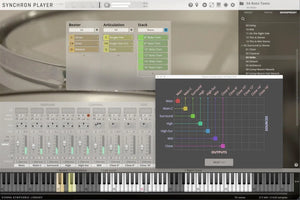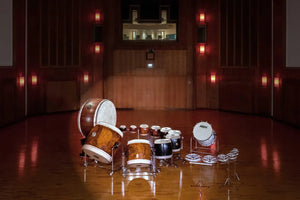Your Cart is Empty




Vienna Synchron Drums II Full
Contains Taikos, Roto Toms, and Bass Drum 2
TEST4b
$0.00$221.00Description
Synchron Drums II
*Synchron Drums II is a subset of the Synchron Percussion II Collection and contains Taikos, Roto Toms, and Bass Drum 2.
Taikos are traditional Japanese keg-shaped drums with horse or cowhide nailed to their frames. Samurai used these drums in order to demoralize their opponents before an attack. Sizes range from very small (like bongos) to gigantic. The first such drums of this type could be found in China more than 2000 years ago.
The traditional playing style using heavy cudgels creates a very hard, accentuated sound. Taikos are often played in ensembles with drums of varying sizes, and utilizing them together can create a dominating, driving rhythm. In the orchestra, taikos are also played with gong mallets. This makes their sound somewhat softer and booming.
For Synchron Percussion II 10 taikos in sizes from 8" to 53" were recorded with up to 12 dynamic levels and eight round robins for single strokes. The taikos were played on the drumhead, side, rim, and the body " with cudgels, gong mallets, brushes, and super ball.
Roto toms were developed in the second half of the 20th century by Michael Colgrass, and further developed by the Remo company. Roto toms consist of skins stretched over a metal frame without a body or shell. Turning the frame changes the skins" tension and thus the pitch of the drums. Since these are tuned drums, they have something in common with the timpani. Therefore, roto toms are often used in place of soprano timpani, and frequently employed when drums with a certain pitch are required.
For this Collection the Vienna team sampled roto toms ranging over 2½ octaves, and played them with sticks, hot rods, and mallets. Apart from single hits, rim hits, rimshots and rolls, the recordings also comprise glissandos, which are created by turning the frame immediately after the hit.
Synchron Percussion's second Bass Drum is a Lefima 28. This traditional large bass drum with its crisp sound was recorded with up to 16 dynamic levels and eight round robins for single strokes.
Articulations are comprised of single hits on various areas of the drum, rolls, upbeats, coperto (covered with a blanket), played with three different mallets (soft, medium, hard). In addition, there are effect articulations such as brushes, sizzle (attaching a sizzle chain to the skin results in a noisy reverberation), and super ball, which is a rubber ball on a stick that is drawn across the skin, creating a kind of humming tone.
12 Microphones
Every instrument was recorded using 12 microphones. You may select from seven different microphone positions (Full Library) and mix them to your liking, directly in the Vienna Synchron Player. Use the included and perfectly fine-tuned presets as a starting point for your own sonic creations. The performances in Stage A were captured in stereo using a Decca tree, and additional microphone arrays were utilized for 5.1 surround and Auro 3D 9.1.
Microphone Positions of the Full Library:
- Close Mic " Mono
- Mid Layer Mic " Stereo (L/R)
- Main/Room Mic " Decca Tree Stereo (L/R)
- Main/Room Mic " Decca Tree Mono (Center)
- Main Surround " Stereo (L/R)
- High Stereo (3D) " Stereo (L/R)
- High Surround (3D) " Stereo (L/R)
Tech Specs
System Requirements
Minimum:
- Windows 10 (latest update, 64-bit), Intel Core i5 or AMD Athlon 64 X2
- macOS 10.14 Mojave (latest update), Intel Core i5
- SSD (M2, SATA 6 or USB3/3.1, UASP Support - HFS+, APFS or NTFS formatted)
- Please check Vienna Symphonic Library website for full RAM requirements
- iLok Account and iLok License Manager for license activation on a physical iLok 2/iLok 3 key or in an iLok Cloud Session (the iLok Cloud requires a constant internet connection!)
- Free storage space for Library, please check Vienna Symphonic Library website for space requirements
Recommended:
- Windows 11 (latest update), Intel Core i7/i9/Xeon
- macOS 13 Ventura (or higher), Intel Core i7/i9/Xeon/M1/M2
- Please check Vienna Symphonic Library website for full RAM recommendations
- AU/VST/VST3/AAX Native compatible host
- 88 key master keyboard







